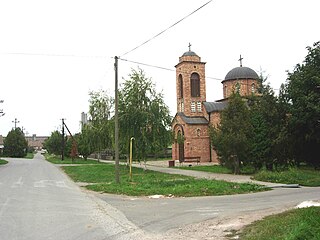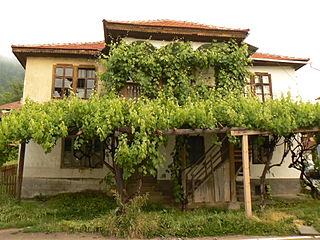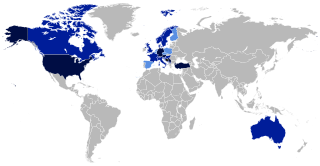
Demographic features of the population of Bosnia and Herzegovina include population density, ethnicity, education level, health of the populace, economic status, religious affiliations and other aspects of the population.

The Federation of Bosnia and Herzegovina is one of the two entities composing Bosnia and Herzegovina, the other being Republika Srpska. The Federation of Bosnia and Herzegovina consists of ten autonomous cantons with their own governments and legislatures.

The Central Banat District is one of seven administrative districts of the autonomous province of Vojvodina, Serbia. It lies in the geographical region of Banat. According to the 2022 census results, it has a population of 157,711 inhabitants. The administrative center is the city of Zrenjanin.

The Kolubara District is one of eight administrative districts of Šumadija and Western Serbia. It occupies the central part of western Serbia. According to the 2011 census results, it has a population of 174,513 inhabitants. The administrative center of the Kolubara District is Valjevo, on the banks of the Kolubara River.

The Raška District is one of eight administrative districts of Šumadija and Western Serbia. It expands to the south-western part of the country. As of 2022 census, the district has a population of 296,532 inhabitants. The administrative center of the Raška district is Kraljevo.

Demographic features of the population of Serbia include vital statistics, ethnicity, religious affiliations, education level, health of the populace, and other aspects of the population.

Mali Iđoš is a village and municipality located in the North Bačka District of the autonomous province Vojvodina, Serbia. The municipality comprises three local communities and has a population of 12,031, of whom 6,486 (53.91%) are ethnic Hungarians, 2,388 are Serbs (19.85%) and 1,956 are Montenegrins (16.26%). Mali Iđoš village has a population of 4,830.

Sečanj is a town located in the Central Banat District of the autonomous province of Vojvodina, Serbia. The town itself has a population of 2,373, while the Sečanj municipality has 13,267 inhabitants.

Bosilegrad is a town and municipality located in the Pčinja District of southern Serbia. The municipality comprises an area of 571 km2 (220 sq mi). According to 2011 census, town has a population of 2,624 inhabitants, while the municipality has 8,129 inhabitants.
Romani people, or Roma, are the fourth largest ethnic group in Serbia, numbering 131,936 (1.98%) according to the 2022 census. However, due to a legacy of poor birth registration and some other factors, this official number is likely underestimated. Estimates that correct for undercounting suggest that Serbia is one of countries with the most significant populations of Roma people in Europe at 250,000-500,000. Anywhere between 46,000 to 97,000 Roma are internally displaced from Kosovo after 1999.

The Turks in Bosnia and Herzegovina also known as Bosnian Turks, are ethnic Turks who form the oldest ethnic minority in Bosnia and Herzegovina. The Turkish community began to settle in the region in the 15th century under Ottoman rule, however, many Turks immigrated to Turkey when Bosnia and Herzegovina came under Austro-Hungarian rule.

Šljivno is a village in the municipality of Banja Luka, Republika Srpska, Bosnia and Herzegovina. The village is currently uninhabited.

Bosnians are people native to the country of Bosnia and Herzegovina, especially the historical region of Bosnia. As a common demonym, the term Bosnians refers to all inhabitants/citizens of the country, regardless of any ethnic, cultural or religious affiliation. It can also be used as a designation for anyone who is descended from the region of Bosnia. Also, a Bosnian can be anyone who holds citizenship of the state of Bosnia and Herzegovina and thus is largely synonymous with the all-encompassing national demonym Bosnians and Herzegovinians.
Yugoslavs in Serbia refers to a community in Serbia that view themselves as Yugoslavs with no other ethnic self-identification. Additionally, there are also Serbs, Croats, Montenegrins, Bosniaks and people of other ethnicities in Serbia who identify themselves as Yugoslavs. However, the latter group does not consider itself to be part of a Yugoslav nation, which is the way the first group identifies itself. People declaring themselves as Yugoslavs are concentrated in multicultural Vojvodina and Belgrade, where slightly over 80% of all Yugoslavs in Serbia are found.
The Balkan Turks or Rumelian Turks are the Turkish people who have been living in the Balkans since the Ottoman rule as well as their descendants who still live in the region today. The Turks are officially recognized as a minority in Bosnia and Herzegovina, Bulgaria, Croatia, Kosovo, North Macedonia, and Romania; in Greece the Turkish minority is recognized as "Greek Muslims". Furthermore, the Turkish language has minority language status in Bosnia and Herzegovina, North Macedonia, and Romania. The Ottoman Empire conquered parts of the Balkans between the 14th and 16th century.
The Schutzkorps was an auxiliary volunteer militia established by Austro-Hungarian authorities in the newly annexed province of Bosnia and Herzegovina to track down Bosnian Serb opposition, while its main victims were civilians. Officially, they were an auxiliary gendarmerie, while in reality, they conducted illegal and repressive activities. It predominantly drew recruits from members of the Bosniak population and it became infamous as a result of its heavy involvement in the persecution of the Serbs. They particularly targeted Serb populated areas of eastern Bosnia.

The Kosovo Agency of Statistics monitors various demographic features of the population of Kosovo, such as population density, ethnicity, education level, health of the populace, economic status, religious affiliations and other aspects of the population. Censuses, normally conducted at ten-year intervals, record the demographic characteristics of the population. According to the first census conducted after the 2008 declaration of independence in 2011, the permanent population of Kosovo had reached 1,810,366.
Mrčići is a small hamlet in the municipality of Pljevlja, Montenegro. It is located at the Bosnian border.
Tomaševo, previous known as Šahovici, is a village in the municipality of Bijelo Polje, Montenegro.

The Albanians of Bosnia and Herzegovina are people of full or partial Albanian ancestry and heritage in Bosnia and Herzegovina.



















